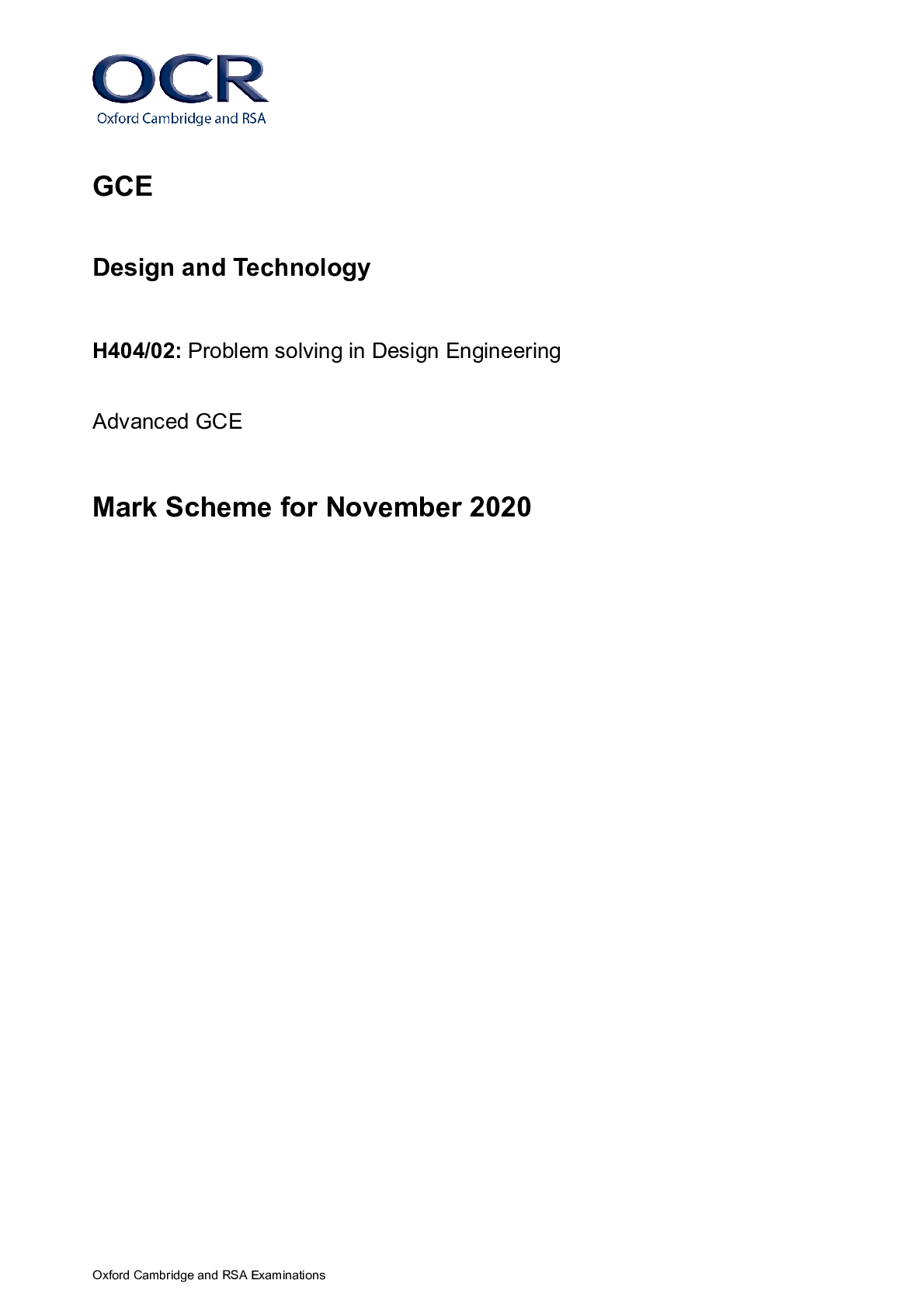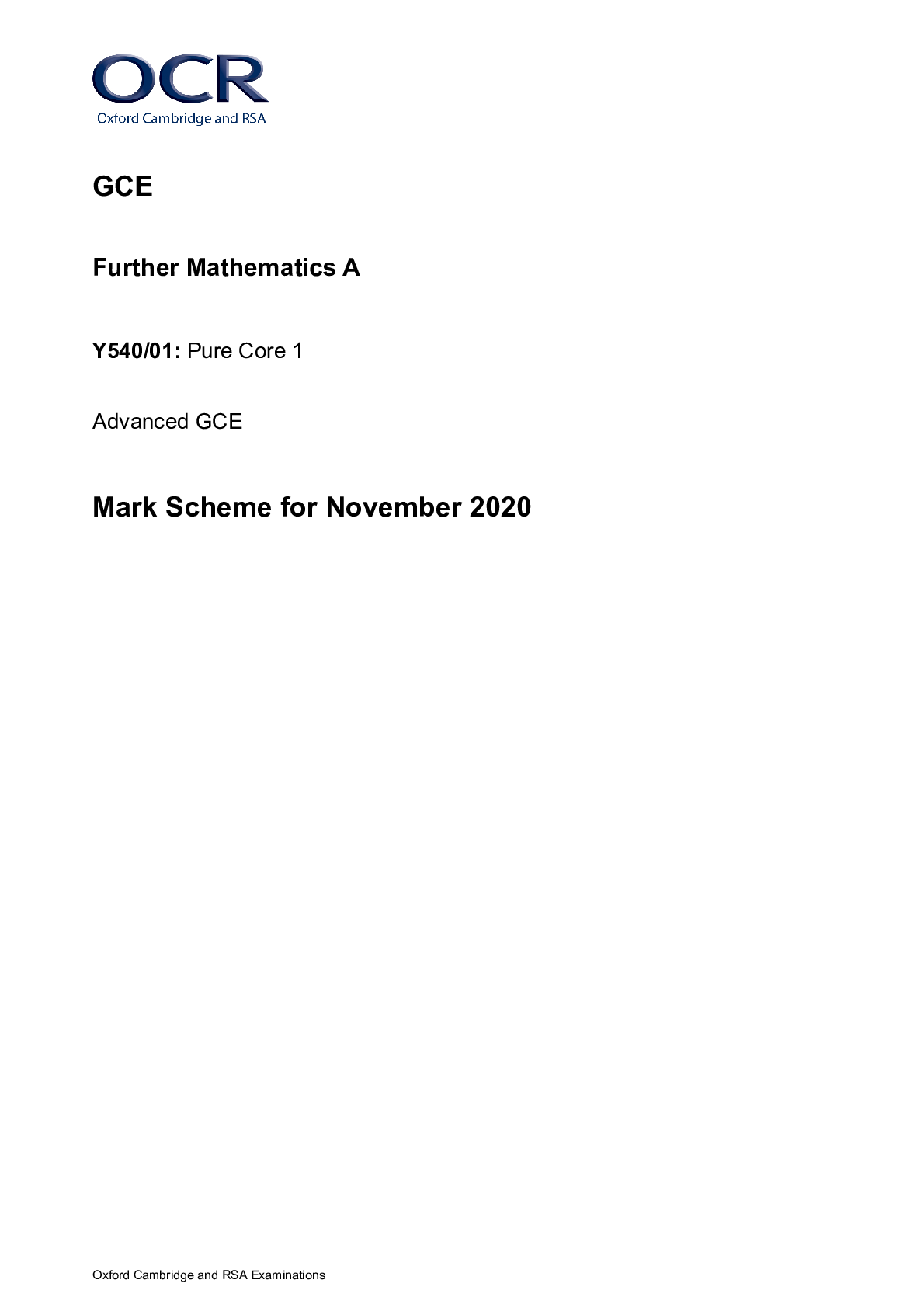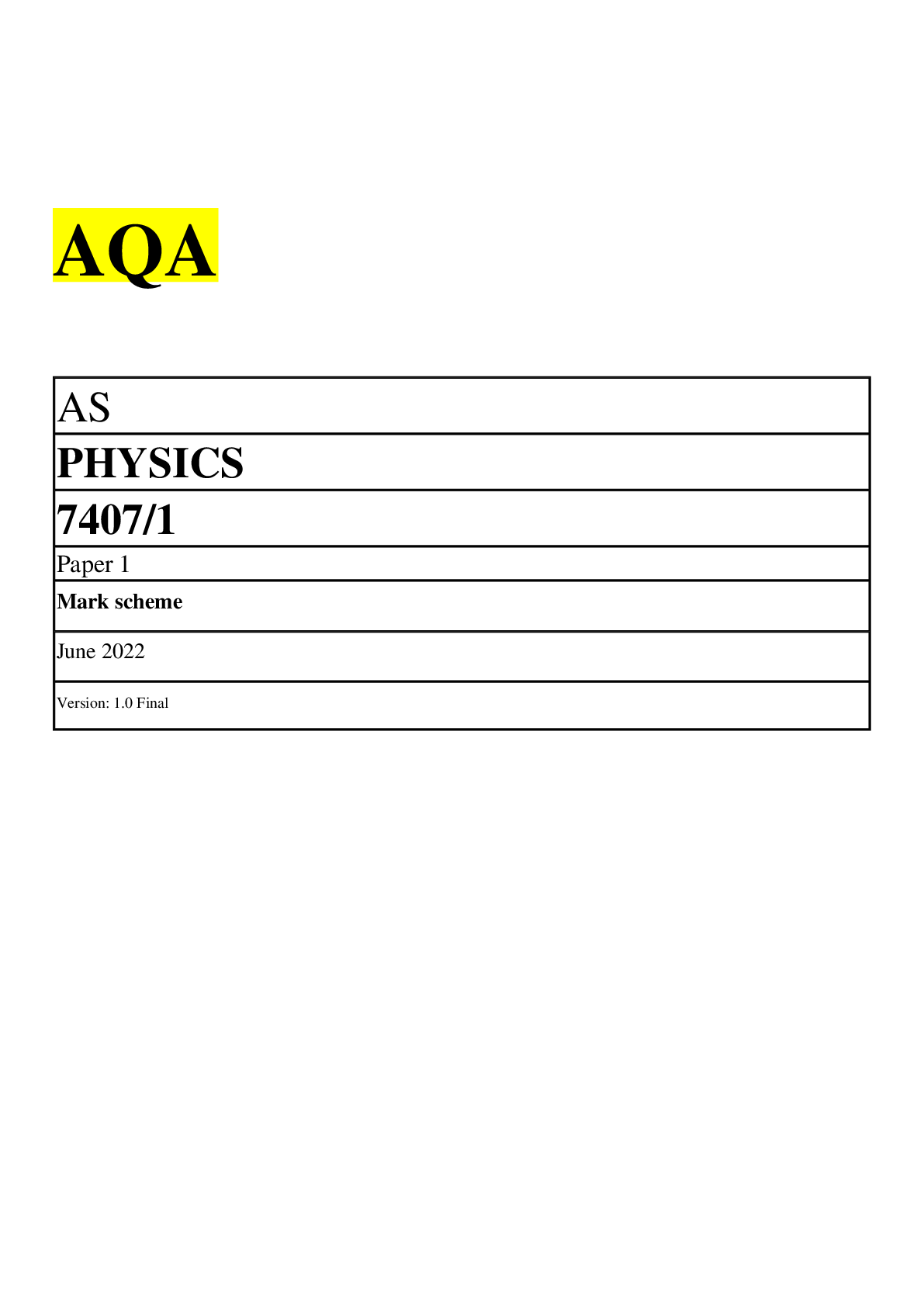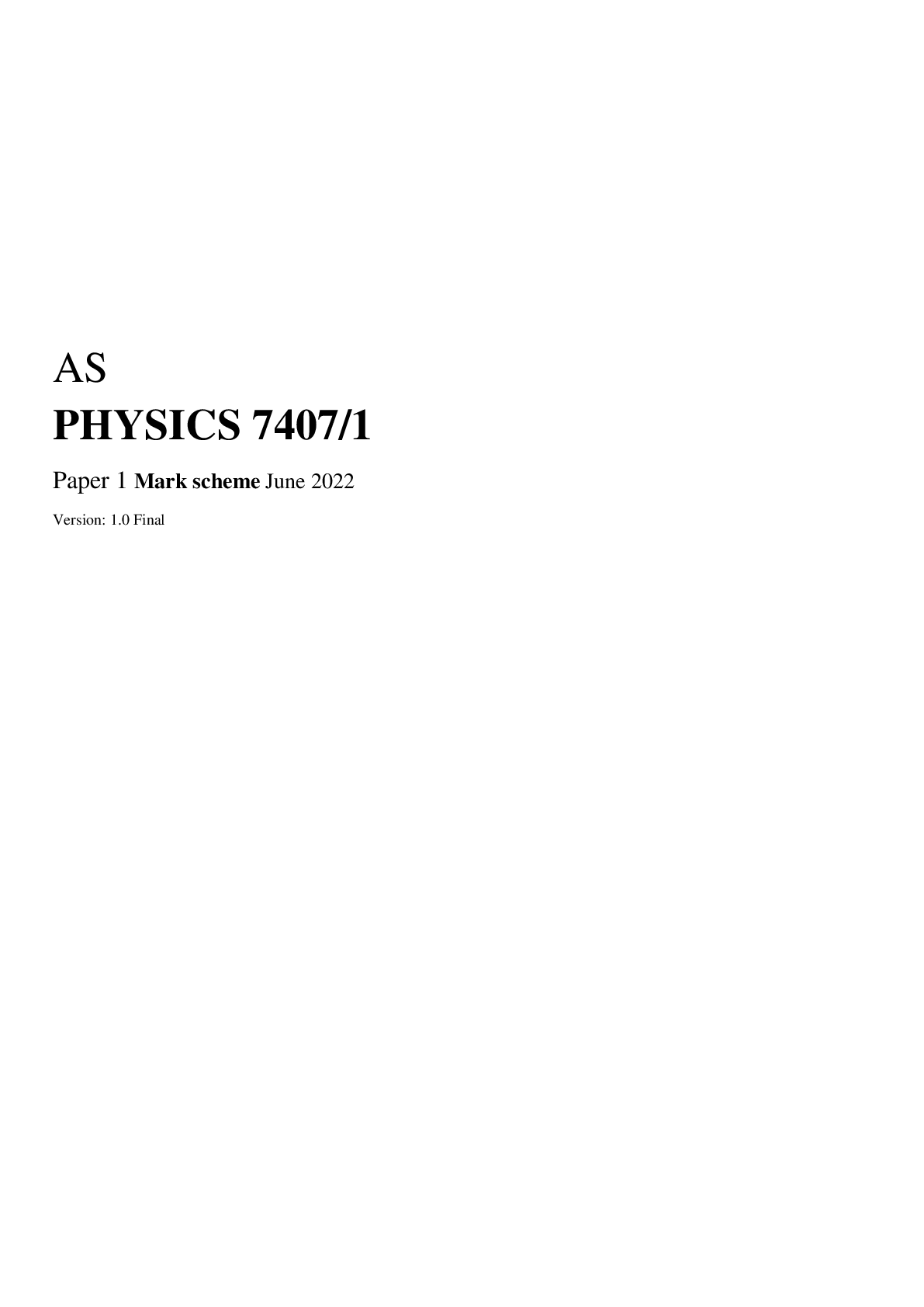Design and Technology > AS Mark Scheme > GCE Design and Technology H404/02: Problem solving in Design Engineering Advanced GCE Mark Scheme fo (All)
GCE Design and Technology H404/02: Problem solving in Design Engineering Advanced GCE Mark Scheme for November 2020
Document Content and Description Below
Oxford Cambridge and RSA Examinations GCE Design and Technology H404/02: Problem solving in Design Engineering Advanced GCE Mark Scheme for November 2020Oxford Cambridge and RSA Examinations OCR ... (Oxford Cambridge and RSA) is a leading UK awarding body, providing a wide range of qualifications to meet the needs of candidates of all ages and abilities. OCR qualifications include AS/A Levels, Diplomas, GCSEs, Cambridge Nationals, Cambridge Technicals, Functional Skills, Key Skills, Entry Level qualifications, NVQs and vocational qualifications in areas such as IT, business, languages, teaching/training, administration and secretarial skills. It is also responsible for developing new specifications to meet national requirements and the needs of students and teachers. OCR is a not-for-profit organisation; any surplus made is invested back into the establishment to help towards the development of qualifications and support, which keep pace with the changing needs of today’s society. This mark scheme is published as an aid to teachers and students, to indicate the requirements of the examination. It shows the basis on which marks were awarded by examiners. It does not indicate the details of the discussions which took place at an examiners’ meeting before marking commenced. All examiners are instructed that alternative correct answers and unexpected approaches in candidates’ scripts must be given marks that fairly reflect the relevant knowledge and skills demonstrated. Mark schemes should be read in conjunction with the published question papers and the report on the examination. © OCR 2020H404/02 Mark Scheme November 2020 2 Annotations Annotation Meaning Blank Page – this annotation must be used on all blank pages within an answer booklet (structured or unstructured) and on each page of an additional object where there is no candidate response. Tick Cross Confused (replaces the question mark) Benefit of doubt AO1 – Knowledge and understanding AO2 – Apply knowledge and understanding AO3 - Analyse AO4 - Evaluation Omission Not answered question Noted but no credit given Too vague Own figure rule RepetitionH404/02 Mark Scheme November 2020 4 Question Answer Mark Guidance 1 Indicative content: Candidates will be expected to make reference to the Resource Booklet in their answer and also demonstrate their understanding of the Social, Economic and marketing considerations of designing fitness equipment. Their answers could include but not be limited to: Social: • Increase in personal self confidence. • Increase in self esteem. • Increase in emotional health. • Interaction with others. • Enables you to perform better at work. • Any other valid suggestion. Economic: • Latest fitness trends affects sales and gym memberships. • Timing of release, it is fact that gyms and the sale of fitness equipment peaks during January every year. • A better level of fitness will save money on the NHS (use information form the resource booklet to back this up). • Increase in specific areas of fitness and the importance of knowing where these are and where they are going to be. • A healthier workforce will require less sick leave meaning a more productive and efficient workforce. • Any other valid suggestion. Market: • Current trends, designing the right piece of equipment for the right trend at the right time. • The age range you are designing for. • The size of the market along with their disposable income to spend of fitness equipment. • The end goal of that market group with regards to fitness. • The life span of a piece of fitness equipment, enabling more detailed development into suitable materials. 14 All responses should be in relation to the social, economic and marketing considerations of fitness equipment. Any lifted information can be used in support of the critical examination but no marks should be awarded simply for duplicating text. Credit should be given for responses which identify issues evident in the supplied information and which are then analysed and evaluated in terms of their significance to the given scenario and relating to design and Level 4 [11-14 marks] A comprehensive discussion of the issues that would be considered. Comprehensive understanding of a wide range (all three) of issues that would be considered when designing a piece of fitness equipment. Information in RB is used effectively to fully exemplify the points being made. Well-constructed narrative in relation to question with clear and supported evaluative comments. Level 3 [7-10 marks] A good discussion of the issues that would be considered. Good understanding of a range (at least 2) of issues that would be considered when designing a piece of fitness equipment. Information in RB is used for the most part effectively to exemplify points being made although one or two opportunities are missed. Well-constructed narrative in relation to question although one or two opportunities missed to develop response. Evaluate comments are clear but not always supported. Level 2 [4-6 marks] A sufficient discussion of the issues that would be considered. Sufficient understanding of issues (at least 1) that would be considered when designing a piece of fitness equipment. Information in RB is used to exemplify some points being made although much more could have been done to exploit the stimulus material available.H404/02 Mark Scheme November 2020 5 • Any other valid suggestion. technical principles. Reasonable narrative in relation to the question although response at times lacks depth and cohesion. Evaluative comments lack clarity and are unsupported. Level 1 [1-3 marks] A limited discussion of the issues that would be considered. Limited knowledge and next to no understanding of issues that would be considered when designing a piece of fitness equipment. Use of information from the RB is used in a simplistic way and adds limited value to the point being made. Limited narrative in relation to question. Response is basic and unstructured with no evaluative comments. 0 marks No response or no response worthy of credit. 2* Indicative content: 14 Level 4 [11-14 marks]H404/02 Mark Scheme November 2020 6 Candidates could consider the following within their answer: • Size of the intended unit, gym space is at a premium and gym owners will not want it taken up by excess equipment. • Charging capabilities i) Ability to charge a range of different devices ii) Acknowledgment of potential different charge requirements for different devices (mention of voltage and current) using the information in table 1. iii) Different charging connections to the mobile devices – wireless charging, lightning 2, USB-C etc. Does it have cables or does the user bring their own cable? iv) The time it takes to charge a device. • The effect on the user experience. Will driving an alternator increase the effort required at each of the levels on the rowing machine. • Materials that would be used in the manufacture, taking into account the environment and the usage. Candidates could discuss a polymer for the case, marks should be awarded for mentioning an appropriate one only with justification. • Suitable systems to connect the new system to the existing flywheel. Pulleys, Gears, Chain and Sprocket etc. • The maintenance of the system when it is in place at the gym, what considerations should be made? Cleaning, repair/replacement of broken cables or USB ports? • Some recognition for the users safety: i) Having a cable around the rowing machine or on the floor of the gym could be a hazard. ii) The voltage and current from the generator could be dangerous if accessible. iii) The system should not interfere at all with the usage of the machine which may cause harm to the user i.e. cause an electric shock to the user. • Users will be at different fitness levels, this will affect the charging time of the devices, and also may create too much current damaging the mobile devices. Suggestion of a current limiter or mention of charge from the battery which will give a constant current output suitable for all devices. • Some method of holding the mobile device and taking into consideration. All responses should be in relation to the design and development the system outlined in the Resource Booklet. Candidates may extract information from any part of the Resource Booklet but specifically page 4 (and possibly pages 2 and 3). Any information should be critically evaluated or applied to the question and no marks should be awarded for simply copying the text. Credit should be given for responses which identify issues evident in the Resource Booklet and which are critically analysed and evaluated in terms of the A comprehensive critical evaluation of the issues a designer would need to consider when developing a charging system for a rowing machine used in a gym. Comprehensive understanding of the issues that would need to be considered. Analysis of product and issues raised re consistently and appropriately aligned with the development of a charging system. Information in RB is used effectively to fully exemplify the points being made. There is a well developed line of reasoning which is clear and logically structured. The information presented is relevant and substantiated. Level 3 [7-10 marks] A good critical evaluation of the issues a designer would need to consider when developing a charging system for a rowing machine used in a gym, Good understanding of the issues that would need to be considered. Analysis of product and issues raised are appropriately aligned with development of a charging system but one or two opportunities are missed to make connections. Information in RB is used for the most part effectively to exemplify points being mad although one or two opportunities are missed. There is a line of reasoning presented with some structure. The information presented is in the most part relevant and supported by some evidence. Level 2 [4-6 marks]H404/02 Mark Scheme November 2020 7 • Any other valid suggestion. significance to the given scenario and relating to the design and technical principles. Candidates can draw on their experience of iterative design and product analysis to support their response to the question. A sufficient critical evaluation of the issues a designer would need to consider when developing a charging system for a rowing machine used in a gym. Sufficient understanding of the issues that would need to be covered. Analysis of product and issues raised are reasonably aligned with development of charging system but there are significant opportunities missed to make connections. Informative in RB is used to exemplify some points being made although much more could have been done to exploit the stimulus material available. The information has some relevance and is presented with limited structure. The information is supported by limited evidence. Level 1 [1-3 marks] A limited examination of the issues a designer would need to consider when developing a charging system for a rowing machine used in a gym. Limited knowledge and next to no understanding of the issues that would need to be covered. Isolated statements made in relation to product and issues raised resulting in only weak alignment with development of charging system. Use of information from the RB is used in a simplistic way and adds limited value to the points being made.H404/02 Mark Scheme November 2020 8 The information is basic and communicated in an unstructured way. The information is supported by limited evidence and the relationship to the evidence may not be clear. 0 marks No response or no response worthy of credit.H404/02 Mark Scheme November 2020 9 3 Indicative content: Issue 1 Required current = 3A Use of Fig. 7 to identify a required generator speed of 1500rpm to produce a current of 3A Calculation of velocity ratio between flywheel and generator: Velocity ratio = 600/1500 = 0.4 Equating the velocity ratio to the ratio of pulley sizes required: Driven pulley (50mm) / driver pulley = 0.4 Determining the driver pulley diameter required on the flywheel: Driver pulley diameter = 50 / 0.4 = 125mm Detailed evidence of a workable method of transferring the drive from the flywheel to the generator pulley, e.g. • Pulley and belt drive • Method of attaching driver pulley to flywheel • Method of tensioning belt • Use of ribbed belt to reduce slipping Method of mounting generator. Issue 2 Identifying a sensor suitable for detecting shaft rotation, e.g. • Slotted opto-switch • Gear tooth sensor • Reed switch • Microswitch • Quadrature encoder etc. Evidence of how the sensor interacts with the rotation of the shaft, e.g • A slotted disk is attached to the pulley. As it rotates, the slotted disk breaks the beam in the opto-switch 16 Award a maximum of 8 marks For Issue 1. There must be evidence that these figures have been deduced for the award of marks. Allow ECF at any stage in the design calculations. Allow 1400 – 1600 rpm as read from graph. No need for explicit mention of velocity ratio. Candidate may describe this as a speed ratio. Allow 1500/600 = 2.5 Allow calculations involving gear systems. Allow 50 x 2.5 Other rotary drive transfer systems may be described, e.g. • Spur gears • Friction wheel on Level 4 [13-16 marks] A comprehensive demonstration of technical solutions to overcome the two issues identified. Comprehensive understanding of technical design and technology principles to overcome the two issues identified. Both solutions are well-developed. Information in RB is used effectively to fully exemplify the points being made. Sketches if used will be clear and supported with relevant notes. The process will be end to end and clear in the way it is explained. Level 3 [9-12 marks] A good demonstration of technical solutions to overcome the two issues identified. Good understanding of technical design and technology principles to overcome the two issues identified. Both solutions will be covered but one of the solutions may be underdeveloped. Information in RB is used for the most part effectively to exemplify points being made although one or two opportunities are missed. Sketches if used will for the most part be clear and supported with relevant notes although one or two opportunities for clarity may be missed. The process will be end to end and for the most part be clear in the way it is explained. Level 2 [5-8 marks] A sufficient demonstration of technical solutions to overcome the two issues identified.H404/02 Mark Scheme November 2020 10 Evidence of the type of signal produced by the sensor, e.g. • The pulses from the slotted opto-switch…… Identifying a specific processing subsystem, e.g. Microcontroller Identifying an output device capable of switching off the charging current, e.g. • Relay • Transistor (MOSFET) Evidence of how the entire system works, e.g. • Microcontroller measures the time interval between each pulse from the slotted opto-switch • If the time interval is less than a specified time then the output to the relay goes high • The relay turns on and allows charging current to flow to the mobile phone. A short time delay would be added in the program loop to prevent the relay switching rapidly on/off as the speed fluctuates around 1000 rpm. circumfere nce of flywheel • Chain and sprocket etc. Award a maximum of 8 marks For Issue 2. Marks are not awarded for the system diagram itself, but for the information it conveys. Sensor may be sketched and annotated. Evidence may be presented in a diagram. The signal may be shown as a graph. The system description may be in the form of a program flowchart. Quantified answers are not necessary, but for full marks, the description must clearly go beyond “The processor monitors the Sufficient understanding of technical design and technology principles to overcome the two issues identified. Both solutions may be covered but both may be underdeveloped. Informative in RB is used to exemplify some points being made although much more could have been done to exploit the stimulus material available. Sketches if used will be adequate and supported with notes, some of which may be relevant. The process may not necessarily be end to end with some knowledge gaps evident. Level 1 [1-4 marks] A limited demonstration of technical solutions to overcome the two issues identified. Limited knowledge and next to no understanding of technical design and principles to overcome either issue identified. Any solution given will be basic. Use of information from the RB is used in a simplistic way and adds limited value to the points being made. Sketches if used will be unclear with only basic notes to accompany them. The end to end process may not exist and if anything is basic in nature. 0 marks No response or no response worthy of credit.H404/02 Mark Scheme November 2020 11 pulses and if they are too slow it turns off the relay”.H404/02 Mark Scheme November 2020 12 4 a Information should be gathered from the Resource Booklet: Vertical height = a + d = 100 + 200 = 300mm (1) �������� �����ℎ (��) = �(3002∗ + 7502) (1) Extended length = 808 mm (1) 3 Award three marks as follows: One mark for calculating the vertical height of the right-angled triangle. One mark for the application of Pythagoras. One mark for calculating the answer. If correct answer is given without working out shown award full marks. Where an incorrect answer is given working out should be used to credit appropriate marks. *Allow error carried forward (ECF) where correct working out is shown. Award marks for any other appropriate method, e.g. trigonometry.H404/02 Mark Scheme November 2020 13 b Information should be gathered from the Resource Booklet: Sin θ = d / L2 (1) θ = Sin-1 (200 / 300) = 41.8° (1) Cos (41.8) = H / (L1+L2) (1) H = Cos (41.8*) x (340 + 300) H = 477mm (to nearest mm) (1) 4 Award four marks as follows: One mark for using trig to calculate the angle of the rack arm with the horizontal. One mark for calculating θ. One mark for trig expression to calculate distance H. One mark for calculating H. If correct answer is given without working out shown award full marks. Where an incorrect answer is given working out should be used to credit appropriate marks. *Allow error carried forward (ECF) where correct working out is shown. Candidates may draw sketches of the triangles involved. Award marks for any other appropriate method. d L θ 2 H 41.8° L1+L2H404/02 Mark Scheme November 2020 14 c Eliminate A and C (1) Calculating the minimum cylinder cross section area required: Area = force / pressure (1) Minimum area required = 1100 / 0.6 = 1833.3 mm2 (1) Area = π/4 (d12 – d22) Area = π/4 (502 – 202) = 1649mm2 (1/1) Area = π/4 (802 – 252) = 4536mm2 (1) Most appropriate cylinder – D (1) 7 Award seven marks as follows: One mark for eliminating cylinders A and C because their extended length is too short (808mm required from answer to 4(a)). The minimum extended cylinder length must have been considered for the award of this mark. One mark for the pressure formula. Allow P = F/A or F = PA One mark for calculating the minimum area. Up to two marks for calculating the instroke area of the Ø50mm cylinder. Award only 1 of the 2 marks for candidates who forget to subtract the piston rod area. They will calculate Ø50mm cylinder area as 1963mm2 One mark for calculating the instroke area of the Ø80mm cylinder. One mark for deducing that Cylinder D is most suitable as it has sufficient area to generate the required force. Allow ECF from piston area calculation (candidates who ignore piston rod area will deduce that Cylinder B is suitable) No marks awarded for guessing Cylinder D without any explanation or reasoning.H404/02 Mark Scheme November 2020 15 5* Within their response, candidates should cover both development and introduction to market. The weighting in the response does not have to be equal with each part. Candidates should clearly show an understanding of the different Digital Design Tools that could be used in the suggested areas. Answers could include but are not limited to: Development: • Use of digital technology to collate and process stakeholder research. i) Questionnaires (online) – enables a wider focus group. Saving costs and aids collation of information. ii) Focus groups using video conferencing – does not rely on ‘local’ groups and could make a focus group of a wide range of people. iii) Methods of presenting the data (spreadsheets) – Produces a clear rest of results that are easy to analysis and get the data from. iv) Social media hits to particular sites. – A large platform with likeminded people, looking for improvements/changes. v) Online social group participation. • Product development stage i) CAD drawings of initial concepts – Allows for quick and high quality representations of the prototypes before production, saving costs and enables quick and easy modifications. ii) Photo realistic representations for presentations – Gives potential investor a clear understanding of the product. – Gives the prototype builders a clear understand of what they are creating. iii) CAE – Stress analysis of certain components before physical prototype or manufacture – saves money and allows for suitable materials to be sort which meet the requirements without going ‘over the top’ costing extra. iv) Computer modelling of any attachment systems to the cars roof to ensure that they fit a wide variety before the expense of physical prototyping. v) CAM – Enables quick and efficient transfer from prototype to manufacture. Speeds up manufacture and quality. Ensures that 12 Candidates should make direct links to the roof mounted bike rack in their responses. Credit should not be awarded for simply listing a number of Digital Design Tools without a direct link to a) the Advantages of that process and b) the roof rack system. Level 4 [10-12 marks] A comprehensive discussion of the advantages to x of using digital design tools. Comprehensive understanding of the advantages of using digital design tools during development and introduction to market of stated product. Analysis of product and issues raised are consistently and appropriately aligned with the stakeholder group in question. Information in RB is used effectively to fully exemplify the points being made. There is a well-developed line of reasoning which is clear and logically structured. The information presented is relevant and substantiated. Level 3 [7-9 marks] A good discussion of the advantages to x of using digital design tools. Good understanding of the advantages of using digital design tools during development and introduction to market of stated product. Analysis of product and issues raised are appropriately aligned with the stakeholder group in question but one or two opportunities are missed to make connections. Information in RB is used for the most part effectively to exemplify points being made although one or two opportunities are missed.H404/02 Mark Scheme November 2020 16 products are to the same standards, especially important in the welding. vi) CAE – Prototyping and simulating the Pneumatic system through a Digital Design Tool would save time and money. • Communication i) Allows for design ideas to be communicated between different groups within the company, either internally or international if manufacture is done elsewhere. Allows for a quick turn around and response time which ultimately saves money. ii) CAD presentation techniques allow for a clear representation of the concept, showing all the workings. Introduction: • Product launch i) Social media could be used to advertise the roof rack on certain social sites to increase awareness. ii) Graphical packages would be used to create presentations for marketing, posters, adverts etc Other appropriate areas within Digital Design can be used if explained. There is a line of reasoning presented with some structure. The information presented is in the most part relevant and supported by some evidence. Level 2 [4-6 marks] A sufficient discussion of the advantages to x of using digital design tools. Sufficient understanding of the advantages of using digital design tools during development and/or introduction to market of stated product. Analysis of product and issues raised are reasonably aligned with the stakeholder group in question but there are significant opportunities missed to make connections. Informative in RB is used to exemplify some points being made although much more could have been done to exploit the stimulus material available. The information has some relevance and is presented with limited structure. The information is supported by limited evidence. Level 1 [1-3 marks] A limited examination of the advantages to x of using digital design tools. Limited knowledge and next to no understanding of the advantages of using digital design tools during developmentH404/02 Mark Scheme November 2020 17 and/or introduction to market of stated product. Isolated statements made in relation to product and issues raised resulting in only weak alignment with the stakeholder group in question. Use of information from the RB is used in a simplistic way and adds limited value to the points being made. The information is basic and communicated in an unstructured way. The information is supported by limited evidence and the relationship to the evidence may not be clear. 0 marks No response or no response worthy of credit.OCR (Oxford Cambridge and RSA Examinations) The Triangle Building Shaftesbury Road Cambridge CB2 8EA [Show More]
Last updated: 3 years ago
Preview 1 out of 18 pages

Buy this document to get the full access instantly
Instant Download Access after purchase
Buy NowInstant download
We Accept:

Reviews( 0 )
$7.50
Can't find what you want? Try our AI powered Search
Document information
Connected school, study & course
About the document
Uploaded On
Oct 10, 2022
Number of pages
18
Written in
All
Additional information
This document has been written for:
Uploaded
Oct 10, 2022
Downloads
0
Views
125

























